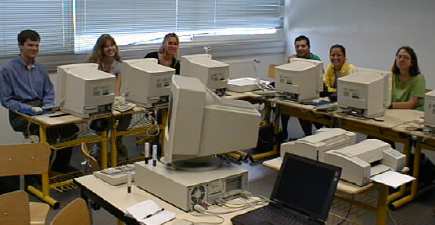
West Virginia University in Vendée, France


Once again I found myself completely humbled by the task before me. In our
next to last class meeting, the indivudual culture and communication projects continue to
amaze all who are present. It's not that what we are being presented to seems so far
away or so abstract as to be incomprehensible. These presentations are alive and
real -- so much so in fact that I will simply be unable to do them justice in the
time and space I have before me. They are about the world we have around us here and
now and as such they are almost an integral part of this place. But these projects
are also about a culture and a language that will from now on be a true part of each 1998
WVU-Vendéen wherever he or she will go from here on.
Megan Sadler began today's session with a thorough and insigtful look into the world of insurance in contemporary France. Among many other things, we learned that the modern insurance industry evolved, along with the industrial revolution, out of the new business world of the 1800's. Her specific project involved not only general research into this business but also in-depth interviews with her host father, Monsieur de Petiville, who has a successful agency here in Les Sables and the surrounding area. In contemporary France, 35.5% of insurance contracts are for life insurance and 20.3% are for auto insurance. Very different from the US is the absence of health insurance from the private insurance business. That is because France has a national health insurance system run by the Republic itself.
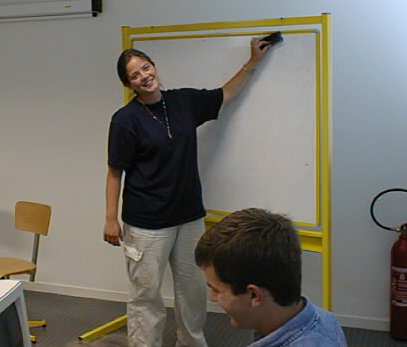
Mona Iskander then followed with a fascinating report on "thalassothérapie". "Thalassa" is the Greek word for the "sea", thus the word means simply "therapy of the sea". As does its name, this form of physical therapy dates back to the ancient Greeks, but it is a real presence in Les Sables today. Mona pointed out that there are basically two approaches to this kind of treatment: 1) "la cure" and 2) "l'espace-forme". For speakers of English, the word "cure" can be misleading since we associate it with the healing of a disease. In French, the word suggests more a type of holistic treatment that strengthens the patients general physical and mental state, thus making him or her better able to deal with a chronic illness like arthritis. The "espace-forme" type of therapy is usually followed by healthy persons seeking to improve their overall health in the absence of any specific disease. Mona's report lead to a very interesting discussion of the differences of conception between American medicine, which seems often focused specifically on disease, and the French view, which seems to look more to the person as a whole. This topic prompted V. Lastinger to mention a visit she had yesterday with her best friend from high school and who is now a physician specializing "scholastic medicine", that is medicine for children in public and private schools. A part of the examination done in school medicine involves having the child draw a picture and then discuss its meaning with the doctor. This may seem a bit "unscientific", but it leads to some very important discoveries about the child's overall physical and mental situation and environment.
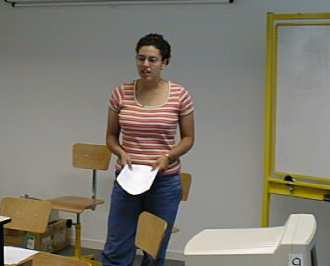
Kristi Widlak then took the floor with an eloquent and informative discussion of marriage in France. She began with the reminder that the only legally recognized marriages in France are those performed by a mayor or magistrate of the Republic. This explains why most French citizens are married twice, once in town hall and then in the Church. Kristi then went on to describe the legal requirements for marriage in France, which include: two individuals of opposite sex, minimum ages of 18 for the male and 15 for the female (though a judge can grant exemptions in special cases, i.e. pregnancy), and no other current marriage. Essentially this means that homosexual marriages are not allowed in France (as they are in some places in the States), that only "adults" may be wed (parents may not wed children to each other), and that polygamy is illegal. Kristi also spoke of the ceremonies associated with marriage, including what they call here "the burial of bachelor life", which is an big celebration for friends and family of both sexes (not like our "stag parties"). Kristi concluded with some notes on country customs, which include some very interesting traditions with origins very deep in the culture.
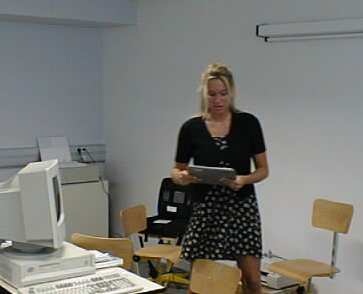
Christin Cox then took the floor with an in-depth report on the traditions and
legends of Vendée. Her research included an interview with the celebrated regional
author and historian Jean Huguet. She underlined the fact that Vendée's legends are
often rooted in its history (going back to Celtic pre-history), its ecology (the swamps,
the salt marshes, and the woodlands), and its religion (both druidic pagan and
Christian). Figures in these stories include woodland nymphs and werewolves as well
as mermaids from the surrounding seas. In the picture below, Christin explains the
significance of the traditional "cordelette", a cord with clay charms that
represent light, fire, water, food, and life. A home with a cordelette will always
be blessed with "un rayon de soleil" (a ray of sunshine). Another of the
stories Christinrelated is that of the region's favorite "Fairy", the legendary
Mélusine. The stories of Mélusine date from the Middle Ages and are contemporary
of those of Arthur, Merlin, and the Lady of the Lake familiar to us. A brief summary
begins with a young knight lost in the forest. He happens upon a beautiful nymph and
falls in love. She accepts to marry him but only on the condition that each night
from Saturday to Sunday she be left completely free and alone. The knight and
Mélusine live happily and have 10 wonderful children, each, however, with a particular
physical deformity -- one with a crooked nose, another with a club foot, etc. One of
those children is the historical figure Geoffroi à la Grande Dent (Jeffrey of the Large
Tooth), a man whose great anger and ambition lead him to lay siege set fire to the Abbey
of Maillezais which we visited on June 18. Mélusine's
marriage went well for many years until one day when her husband was no longer able to
contain his curiosity. He thus followed her one dark Saturday night to the topmost
tower of their castle. To his great surprise he burst in upon his wife, naked
in her bath: she bore two great wing and her body was covered with scales of
silver. She jumped up from her bath, flying out from the tower's window never to be
seen again. But all in Vendée know that her spirit still hovers in the shimmering
light of every sunset over this blessed part of the world.
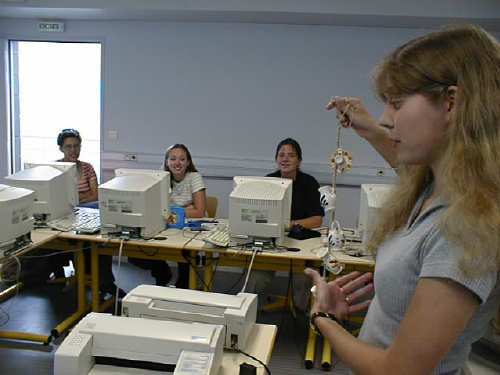
Susan Cressman was next with a presentation on family life in Les
Sables. She noted that the traditional family structure is very similar to that in
the US. In France, however, there are many factors that help families to maintain a
very close network of relations. The parent in Susan's family, for example, both
work on the very steet where their home is located. Others in the class noted that
the shops or offices of their family were actually on the ground floor of their
home. Like many in France, the children in Sue's home have a long lunch break and
come home to be with their parents at meal time, the midday break being a precious but
slowly disappearing tradition in France. Sue pointed out that the house where she
lives was entirely redesigned by the Gilbert family in order open up a large an pleasant
space for family gatherings. The discussion that followed brought out the fact that
the standard work and school week as well as the uniform and extensive vacation time
provided many extra opportunities for French families to enjoy time together.
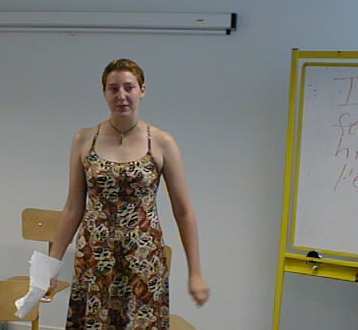
Our last, but certainly not least, presentation today was offered by Cristy Vogel. Cristy has researched the inner workings of the secondary education system in France. She began with an outline of the administrative hierarchy that runs from the National Ministry of Education down to the individual classroom, where French students this week will receive the results the all important Baccalaureate examinations. Among the items Cristy provided for us was a copy of the French section of this year's "Bac". This one section of the exam was designed to last four hours. Other sections run from three up to six hours (with no break allowed), and the full slate of exams covers the last two to three weeks of the school year. Those receiving positive results, which are released all over France today, will be able to go off for a well deserved vacation. Those with mixed results will have to go back for another series of oral exams. Those failing will have decide whether to repeat the exams next year or move on to life in the "real" world without a high school degree.
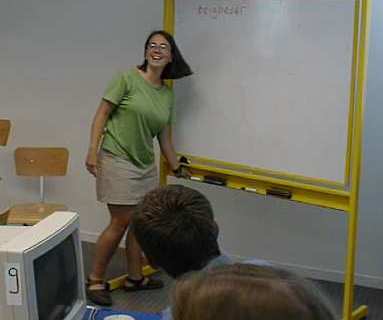
Stay tuned to WVU-V!
Go on to July 7, 1998.